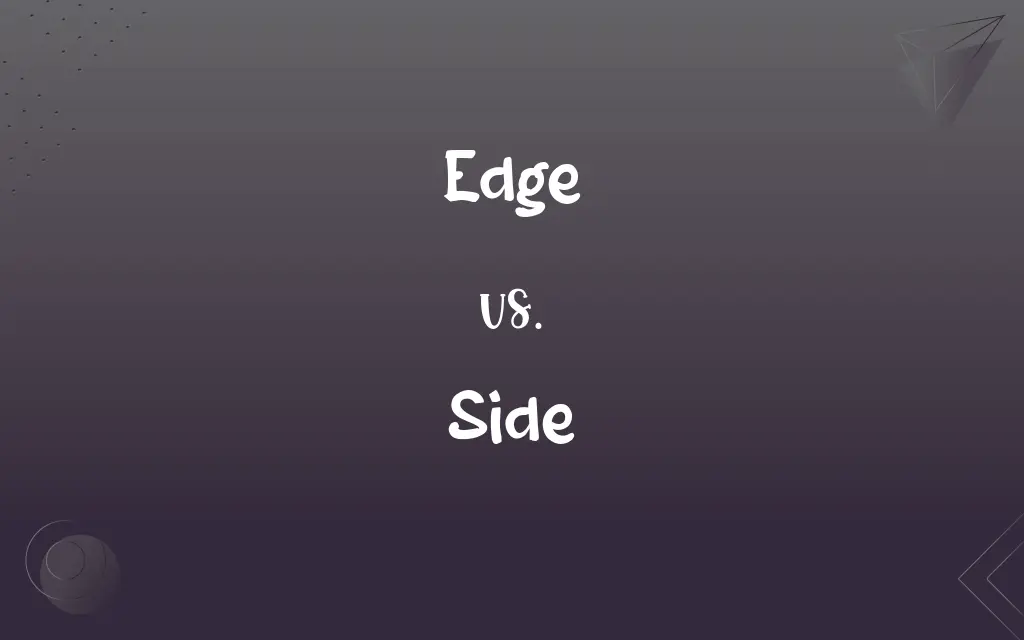Edge vs. Side: What's the Difference?
Edited by Aimie Carlson || By Janet White || Published on January 7, 2024
An edge is the sharp or distinct boundary of a surface, while a side is a flat, broader surface of an object or concept.

Key Differences
An edge is typically defined as the sharp or distinct boundary of a surface, often where two surfaces meet, creating a line or border. A side, in contrast, refers to a flat or curved surface of an object, extending between its edges. The edge is more about the boundary, while the side is about the face or surface.
When interacting with objects, the edge is often perceived as a line or a point of transition, potentially sharp or distinct. On the other hand, a side is viewed as a broader area or surface, providing a sense of the object's shape and size. The edge is a point of demarcation, while the side is a zone of extension.
In practical terms, the edge of an object can be crucial for cutting or joining, serving as a point of interaction. The side of an object often serves for support, display, or containment, highlighting its functional versatility. The edge is about interaction and precision, whereas the side is about utility and space.
Symbolically, an edge can represent a boundary, limit, or a point of transition, often used metaphorically to describe critical or extreme conditions. A side, however, can symbolize a stance, perspective, or affiliation, denoting inclusivity or belonging. The edge symbolizes a limit or transition, while the side represents position or alignment.
In geometry, an edge is a line where two faces of a three-dimensional figure meet, playing a crucial role in defining shape. A side, however, is a single face of a two- or three-dimensional figure, contributing to the figure’s overall form. The edge is about convergence and delineation, while the side is about form and extent.
ADVERTISEMENT
Comparison Chart
Definition
Boundary line of a surface
One of the flat surfaces of a 3D object
Function
Often used for cutting or joining
Typically provides structure or support
Perception
Perceived as a line or transition point
Seen as a broader area or surface
Symbolic Meaning
Represents limits or transitions
Symbolizes position or alignment
Geometrical Role
Line where two faces meet
Single face of a figure
ADVERTISEMENT
Edge and Side Definitions
Edge
Edge can imply being on the brink of something.
He was on the edge of discovering the truth.
Side
Side is one of the surfaces forming the outside of an object.
Paint the side of the barn red.
Edge
Edge is the border where two surfaces meet.
The edge of the paper was sharp and neat.
Side
Side refers to a position of support or opposition in a conflict.
She always takes her friend's side in arguments.
Edge
Edge can mean a competitive advantage.
Her experience gave her an edge in the competition.
Side
Side refers to the left or right part of something.
He was hit on the left side of his face.
Edge
Edge refers to the sharp side of a blade.
The edge of the knife was finely honed.
Side
In cuisine, side means an additional dish accompanying the main course.
I ordered a salad as my side.
Edge
Edge represents an intense or heightened state.
The suspense in the movie kept me on the edge of my seat.
Side
Side can mean an aspect or part of something.
We explored every side of the issue.
Edge
A thin, sharpened side, as of the blade of a cutting instrument.
Side
A line bounding a plane figure.
Edge
The degree of sharpness of a cutting blade.
Side
A surface bounding a solid figure.
FAQs
Can an object have multiple edges?
Yes, objects, especially geometric, can have multiple edges where surfaces converge.
Can side imply partiality?
Yes, taking a side means supporting a particular view or group.
Does side have a role in politics?
In politics, a side typically represents a particular party or ideology.
What is an edge?
An edge is the boundary where two surfaces meet, often sharp or distinct.
Is side always flat?
Not necessarily; sides can be curved, as in a cylinder.
Does the term side apply to geometry?
Yes, in geometry, a side is a face of a two- or three-dimensional figure.
What does side mean?
A side refers to a flat or curved surface of an object, or a position in a conflict.
How are edges important in tools?
Edges in tools like knives are critical for cutting efficiency.
Are edges always sharp?
Not always; some edges, like those on a cube, are not sharp.
Can side refer to additional food items?
Yes, in dining, a side refers to an additional dish served with the main course.
Can side have a symbolic meaning?
Yes, it can symbolize a stance or perspective in a debate or conflict.
How does edge function in competitive contexts?
In competition, having an edge means having a distinct advantage.
What is the significance of edges in design?
Edges are important in design for aesthetics and functional purposes.
Can an edge be symbolic?
Yes, edges can symbolize limits or critical transitions.
What role do edges play in safety?
In safety, sharp or rough edges are often mitigated to prevent harm.
Are edges important in nature?
Edges in nature, like coastlines, can be crucial for ecological balance.
Is side always visible?
In most cases, yes, but it can also refer to hidden aspects.
Can side be used in sports?
Yes, in sports, side can refer to a team or part of a playing area.
How is edge used in expressions?
Expressions like 'on the edge' signify being in a state of suspense or intensity.
How does side function in architecture?
In architecture, sides form the exterior surfaces of structures, affecting aesthetics and function.
About Author
Written by
Janet WhiteJanet White has been an esteemed writer and blogger for Difference Wiki. Holding a Master's degree in Science and Medical Journalism from the prestigious Boston University, she has consistently demonstrated her expertise and passion for her field. When she's not immersed in her work, Janet relishes her time exercising, delving into a good book, and cherishing moments with friends and family.
Edited by
Aimie CarlsonAimie Carlson, holding a master's degree in English literature, is a fervent English language enthusiast. She lends her writing talents to Difference Wiki, a prominent website that specializes in comparisons, offering readers insightful analyses that both captivate and inform.






































































